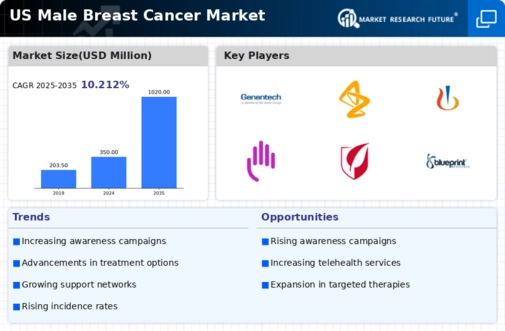Increasing Incidence Rates
The male breast-cancer market is experiencing a notable increase in incidence rates, which appears to be a significant driver for the industry. Recent data indicates that approximately 1.3% of all breast cancer cases in the US are diagnosed in men, with an estimated 2,650 new cases expected in 2025. This rising trend in diagnoses may lead to heightened demand for treatment options and support services, thereby expanding the market. Furthermore, as awareness grows regarding male breast cancer, more men are likely to seek medical advice, contributing to earlier detection and treatment. This shift in patient demographics and increased visibility of the disease could potentially reshape the landscape of the male breast-cancer market, prompting healthcare providers to adapt their strategies to meet the evolving needs of this patient population.
Impact of Public Health Campaigns
Public health campaigns aimed at increasing awareness of male breast cancer are playing a pivotal role in shaping the male breast-cancer market. These initiatives, often spearheaded by health organizations and advocacy groups, seek to educate the public about the risks and symptoms associated with male breast cancer. As these campaigns gain momentum, they may lead to a greater understanding of the disease among men, prompting earlier detection and treatment. The potential for increased screening rates could significantly influence market dynamics, as more men seek medical attention. Furthermore, the visibility created by these campaigns may encourage pharmaceutical companies to invest in research and development for male-specific treatments, thereby driving innovation within the male breast-cancer market.
Growing Support Networks and Resources
The establishment of growing support networks and resources for male breast cancer patients is becoming a crucial driver in the male breast-cancer market. Organizations dedicated to raising awareness and providing support are increasingly emerging, offering resources tailored specifically for men. These networks not only facilitate access to information but also foster community among patients, which can be vital for emotional and psychological well-being. As these support systems gain traction, they may encourage more men to seek diagnosis and treatment, thereby increasing market demand. Additionally, the presence of these resources can enhance the overall patient experience, potentially leading to improved treatment adherence and outcomes, which are essential for the growth of the male breast-cancer market.
Advancements in Research and Development
Ongoing advancements in research and development are poised to significantly impact the male breast-cancer market. The industry is witnessing a surge in funding for research initiatives aimed at understanding the unique biological mechanisms of male breast cancer. This focus on R&D is likely to lead to the discovery of novel therapeutic agents and treatment modalities tailored specifically for men. For instance, the National Cancer Institute has allocated substantial resources to studies exploring genetic predispositions and targeted therapies. As these innovations emerge, they may enhance treatment efficacy and improve patient outcomes, thereby driving growth in the male breast-cancer market. The potential for breakthrough therapies could also attract investment from pharmaceutical companies, further stimulating market expansion.
Insurance Coverage and Reimbursement Policies
Insurance coverage and reimbursement policies are critical factors influencing the male breast-cancer market. As awareness of male breast cancer increases, insurance providers are beginning to recognize the necessity of covering diagnostic and treatment services for male patients. Recent changes in policy have led to improved access to care, which may encourage more men to pursue necessary medical interventions. For instance, some insurance plans are now offering coverage for genetic testing and targeted therapies, which were previously limited. This shift in reimbursement practices could potentially lead to a broader acceptance of treatment options, thereby expanding the male breast-cancer market. As more men receive coverage for their healthcare needs, the overall market dynamics may evolve, reflecting a more inclusive approach to male breast cancer.






















Leave a Comment